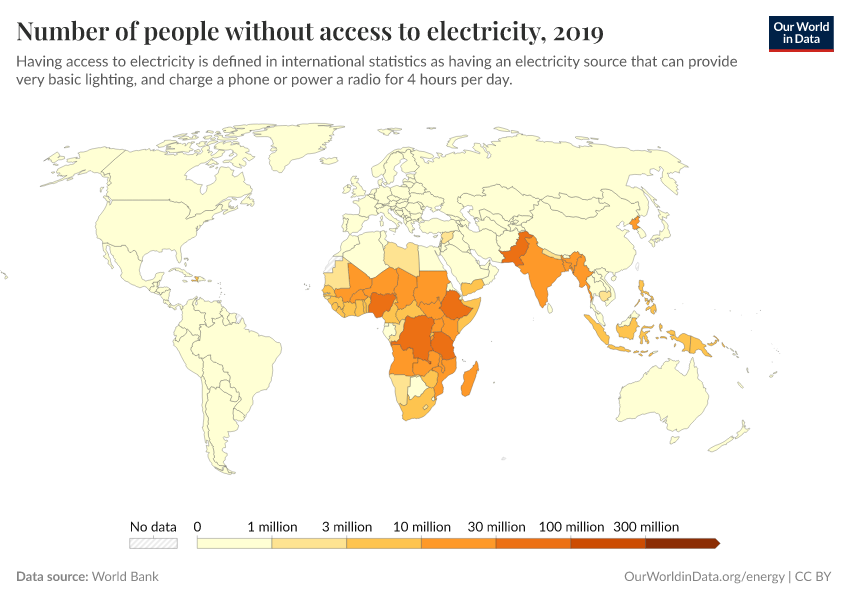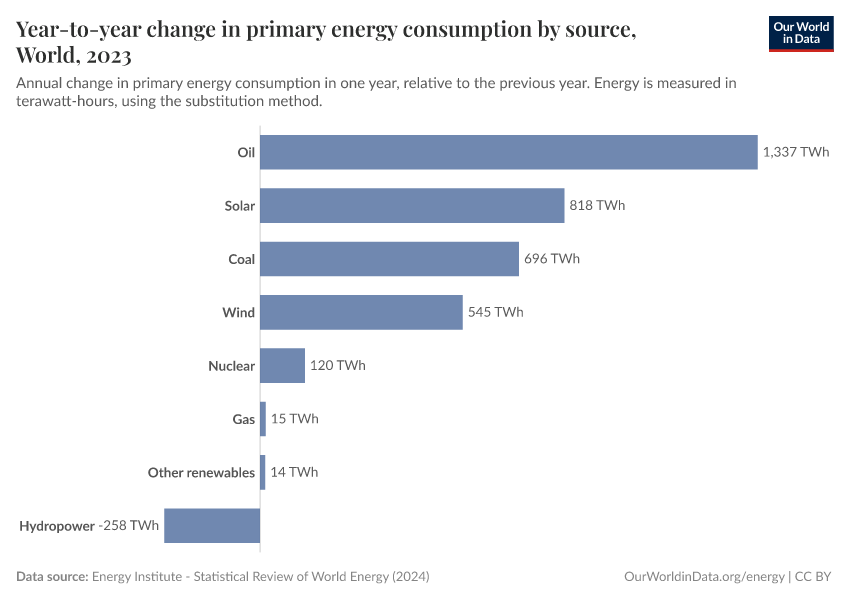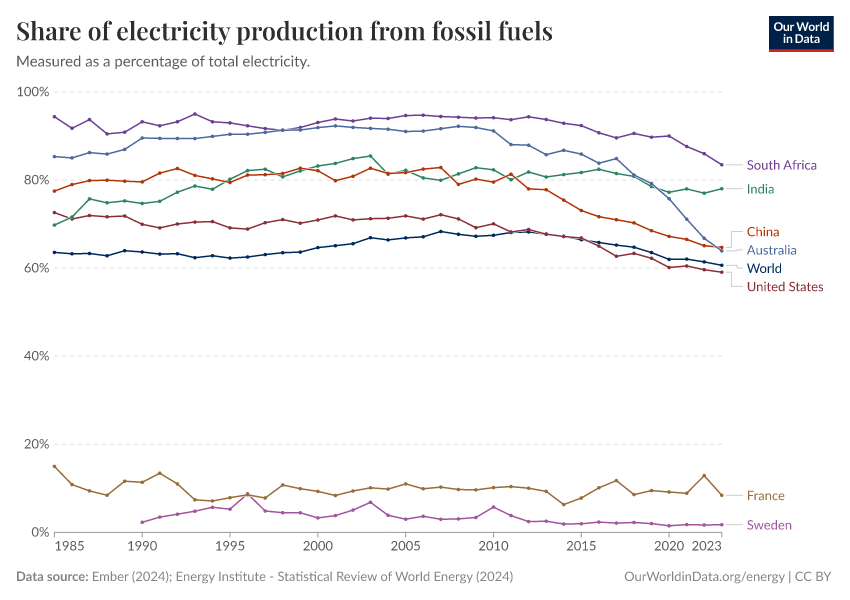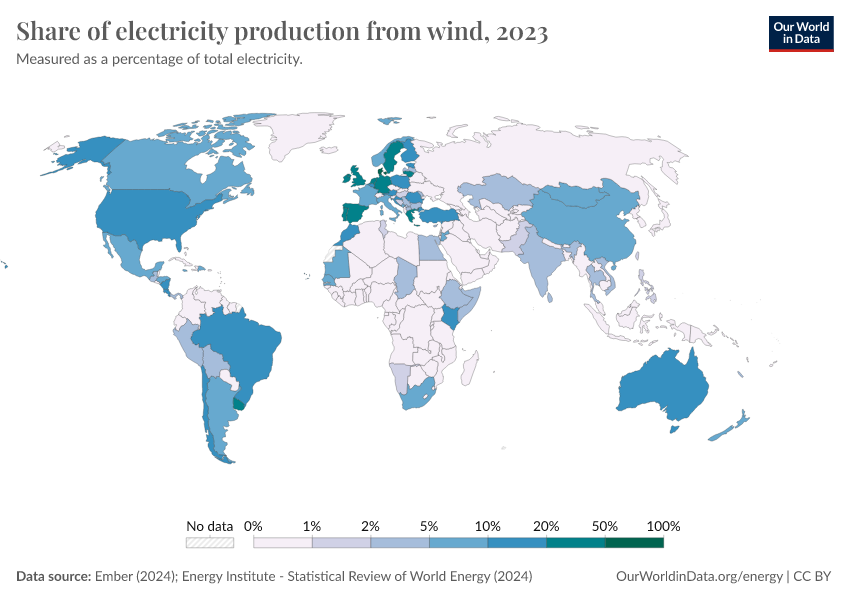Many of us want an overview of how much energy our country consumes, where it comes from, and if we’re making progress on decarbonizing our energy mix. This page provides the data for your chosen country across all of the key metrics on this topic.
In the selection box above you can also add or remove additional countries and they will appear on all of the charts on this page. This allows you to compare specific countries you might be interested in, and measure progress against others.
In the energy domain, there are many different units thrown around – joules, exajoules, million tonnes of oil equivalents, barrel equivalents, British thermal units, terawatt-hours, to name a few. This can be confusing, and make comparisons difficult. So at Our World in Data we try to maintain consistency by converting all energy data to watt-hours. We do this to compare energy data across different metrics and sources.
We will continue to update our data and charts with the latest global and country figures – typically on an annual basis.
Tanzania: What share of the population have access to electricity?
Electricity is a good that adds massive value to modern life: from having light at night; to washing clothes; cooking meals; running machinery; or connecting with people across the world. Many would argue that it is a crucial for poverty alleviation, economic growth and improved living standards.1
This interactive chart shows the percentage of people that have access to electricity.
Two tips on how you can interact with this chart
- Add any other country to this chart: click on the Edit countries and regions button to compare with any other country.
- View this data on a world map: switch to a global map of confirmed deaths using the ‘MAP’ tab at the bottom of the chart.
Tanzania: What share of the population have access to clean fuels for cooking?
Having clean fuels and technologies for cooking – meaning non-solid fuels such as natural gas, ethanol or even electric technologies – makes these processes more efficient, saving both time and energy.
But it also comes with massive health benefits. The use of solid fuels for cooking – such as charcoal, crop waste, or dung – is a primary risk factor for deaths and ill-health from indoor air pollution.
This interactive chart shows the percentage of the population that have access to clean cooking fuels for cooking.
Tanzania: Per capita: what is the average energy consumption per person?
When we compare the total energy consumption of countries the differences often reflect differences in population size.
It’s useful to look at differences in energy consumption per capita.
This interactive chart shows the average energy consumption per person each year.
A few points to keep in mind when considering this data:
- These figures reflect energy consumption – that is the sum of all energy uses including electricity, transport and heating. Many people assume energy and electricity to mean the same, but electricity is just one component of total energy consumption. We look at electricity consumption later in this profile.
- These figures are based on primary energy consumption – given by the ‘substitution method’. You can read our explainer on the different metrics used to measure energy here.
Tanzania: How much energy does the country consume each year?
How much total energy – combining electricity, transport and heat – does the country consume each year?
This interactive chart shows primary energy consumption for the country each year.
Tanzania: How is energy consumption changing from year-to-year?
Many countries have seen large increases in the amount of energy they consume year-on-year, as people get richer and populations grow.
How is total energy consumption changing from year-to-year? Is demand increasing or decreasing?
This interactive chart shows the annual change in primary energy consumption, given as a percentage of the previous year.
Tanzania: Per capita: how much electricity is generated per person?
Electricity is often the most ‘visible’ form of energy that we rely on day-to-day – it keeps our lights, TVs, computers and internet running.
How much electricity is generated per person?
This interactive chart shows per capita electricity generation.
A point to keep in mind when considering this data:
- These figures reflect electricity generation, which is one component of total energy consumption. People often use the terms ‘electricity’ and ‘energy’ interchangeably, but it’s important to remember that the amount of electricity we use is just one part of our total energy demand.
Tanzania: How much electricity does the country generate each year?
- What sources does the country get its energy from?
- How much of the country’s energy comes from fossil fuels?
- How much of the country’s energy comes from low-carbon sources?
- How much of the country’s energy comes from renewables?
- How much of the country’s energy comes from nuclear power?
- How much is consumption of energy sources changing each year?
Tanzania: What sources does the country get its energy from?
Where do countries get their energy from – coal, oil, gas, nuclear energy or renewables? It’s usually some combination of some, if not all, of these sources.
But the energy mix – the balance of sources of energy in the supply – is becoming increasingly important as countries try to shift away from fossil fuels towards low-carbon sources of energy (nuclear or renewables including hydropower, solar and wind).
These interactive charts show the energy mix of the country.
One is presented as a stacked area chart – allowing us to see a full breakdown of the sources of energy in the supply. The line chart shows the percentage of total energy supplied by each source.
How you can interact with the stacked area chart
- In these charts it is always possible to switch to any other country in the world by choosing Change Country in the bottom left corner.
- By unticking the ‘Relative’ box, you can switch to see the breakdown of emissions in absolute terms.
Tanzania: How much of the country’s energy comes from fossil fuels?
Since the Industrial Revolution, fossil fuels have become the dominant energy source for most countries across the world.
But the burning of fossil fuels – coal, oil, and gas – is responsible for around three-quarters of global greenhouse gas emissions. They are also a major source of air pollution, which is responsible for at least five million premature deaths every year.
For both climate change and human health, we want to transition away from fossil fuels. But how quickly are we making progress on this?
This interactive chart shows the share of energy that comes from fossil fuels.
Tanzania: How much of the country’s energy comes from low-carbon sources?
To reduce CO2 emissions and exposure to local air pollution, we want to transition our energy systems away from fossil fuels towards low-carbon sources.
Low-carbon energy sources include nuclear and renewable technologies.
This interactive chart allows us to see the country’s progress on this. It shows the share of energy that comes from low-carbon sources. We look at data on renewables and nuclear energy separately in the sections which follow.
Tanzania: How much of the country’s energy comes from renewables?

Related charts:
Low-carbon energy can come from nuclear or renewable technologies. How big of a role do renewable technologies play?
This interactive chart shows the share of energy that comes from renewables.
A few points to note about this data:
- Renewable energy here is the sum of hydropower, wind, solar, geothermal, modern biomass and wave and tidal energy.
- Traditional biomass – the burning of charcoal, crop waste, and other organic matter – is not included. This can be an important energy source in lower-income settings.
Tanzania: How much of the country’s energy comes from nuclear power?
Nuclear energy – alongside renewables – is a low-carbon energy source. For a number of countries, it makes up a large share of energy consumption.
This interactive chart shows the share of energy that comes from nuclear sources.
Tanzania: How much is consumption of energy sources changing each year?
When looking at longer historical data it can be difficult to see how the energy mix is changing from year-to-year. Are we adding more renewables than fossil fuels? Are we in fact reducing our consumption of coal or oil?
This interactive chart shows the change in primary energy consumption from these sources each year. A positive figure means the country consumed more energy from that source than the previous year; a negative means it consumed less.
How you can interact with this chart
- In these charts it is always possible to switch to any other country in the world by choosing Change Country in the bottom left corner.
- By unticking the ‘Relative’ box, you can switch to see the breakdown of emissions in absolute terms.
- What sources does the country get its electricity from?
- How much of the country’s electricity comes from fossil fuels?
- How much of the country’s electricity comes from low-carbon sources?
- How much of the country’s electricity comes from renewables?
- How much of the country’s electricity comes from nuclear power?
Tanzania: What sources does the country get its electricity from?
Where do countries get their electricity from – coal, oil, gas, nuclear energy or renewables? It’s usually some combination of some, if not all, of these sources.
But the electricity mix – the balance of sources of electricity in the supply – is becoming increasingly important as countries try to shift away from fossil fuels towards low-carbon sources of electricity (nuclear or renewables including hydropower, solar and wind).
These interactive charts show the electricity mix of the country.
One is presented as a stacked area chart – allowing us to see a full breakdown of the sources of electricity in the supply. The line chart shows the percentage of electricity supplied by each source.
A point to keep in mind when considering this data:
Electricity is just one component of total energy – the other two being transport and heating. The electricity mix should not be misinterpreted as the breakdown of the total energy mix. We look at the importance of this difference here.
Tanzania: How much of the country’s electricity comes from fossil fuels?
Since the Industrial Revolution, fossil fuels have become the dominant electricity source for most countries across the world.
But the burning of fossil fuels – coal, oil, and gas – is responsible for around three-quarters of global greenhouse gas emissions. They are also a major source of air pollution, which is responsible for at least five million premature deaths every year.
For both climate change and human health, we want to transition away from fossil fuels. But how quickly are we making progress on this?
This interactive chart shows the share of electricity that comes from fossil fuels.
Tanzania: How much of the country’s electricity comes from low-carbon sources?
To reduce CO2 emissions and exposure to local air pollution, we want to transition our electricity away from fossil fuels towards low-carbon sources.
‘Low-carbon electricity’ includes nuclear and renewable technologies.
This interactive chart allows us to see the country’s progress on this. It shows the share of electricity that comes from low-carbon sources. We look at data on renewables and nuclear power separately in the sections which follow.
Tanzania: How much of the country’s electricity comes from renewables?
Low-carbon electricity can come from nuclear or renewable technologies. How big of a role do renewable technologies play?
This interactive chart shows the share of electricity that comes from renewables.
A few points to note about this data:
- Renewable electricity here is the sum of hydropower, wind, solar, geothermal, modern biomass and wave and tidal power.
- Traditional biomass – the burning of charcoal, crop waste, and other organic matter – is not included. This can be an important source in lower-income settings.
Tanzania: How much of the country’s electricity comes from nuclear power?
Tanzania: Energy intensity: how much energy does it use per unit of GDP?
Energy is a large contributor to CO2 – the burning of fossil fuels accounts for around three-quarters of global greenhouse gas emissions. So, reducing energy consumption can inevitably help to reduce emissions. However, some energy consumption is essential to human wellbeing and rising living standards.
Energy intensity can therefore be a useful metric to monitor. Energy intensity measures the amount of energy consumed per unit of gross domestic product. It effectively measures how efficiently a country uses energy to produce a given amount of economic output. A lower energy intensity means it needs less energy per unit of GDP.
This interactive chart shows energy intensity.
Two tips on how you can interact with this chart
- Add any other country to this chart: click on the Edit countries and regions button to compare with any other country.
- View this data on a world map: switch to a global map of confirmed deaths using the ‘MAP’ tab at the bottom of the chart.
Tanzania: Carbon intensity: how much carbon does it emit per unit of energy?
Energy intensity – shown in the chart above – is one important metric to monitor whether countries are making progress in reducing emissions. The other key part of this equation is carbon intensity: the amount of CO2 emitted per unit of energy.
We can reduce emissions by (1) using less energy; and/or (2) using lower-carbon energy.
This metric monitors the second option. As we transition our energy mix towards lower-carbon sources (such as renewables or nuclear energy), the amount of carbon we emit per unit of energy should fall.
This chart shows carbon intensity – measured in kilograms of CO2 emitted per kilowatt-hour of energy generated.


































